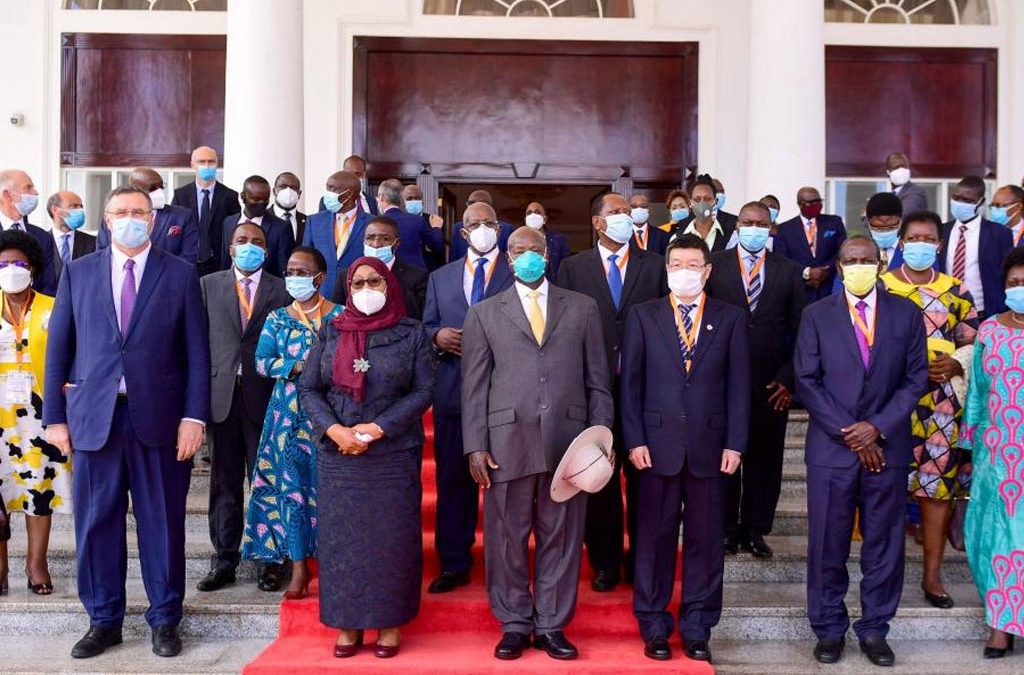The East African Crude Oil Pipeline (EACOP) project represents one of the most significant energy infrastructure developments in East Africa. On April 11, 2021, a landmark agreement was signed between Uganda, Tanzania, TotalEnergies, and CNOOC, marking a critical milestone in the commercialization of Uganda’s oil resources. The deal, witnessed by Uganda’s President Yoweri Museveni and Tanzania’s President Samia Suluhu Hassan, unlocked billions of dollars in investments, setting the stage for regional economic transformation.
This article provides an in-depth analysis of the 2021 EACOP deal, covering:
- Background of Uganda’s Oil Discoveries
- The Significance of the EACOP Project
- Key Players: Governments, TotalEnergies, and CNOOC
- The 2021 Agreement: Terms and Implications
- Economic and Geopolitical Impact
- Environmental and Social Concerns
- The Future of EACOP and East Africa’s Energy Sector
- Background of Uganda’s Oil Discoveries
Uganda’s oil journey began in 2006 when significant reserves were discovered in the Albertine Graben, a hydrocarbon-rich region near the border with the Democratic Republic of Congo (DRC). Estimates suggest Uganda holds 6.5 billion barrels of oil, with 1.4 billion barrels recoverable.
However, commercializing these reserves faced delays due to:
- Infrastructure gaps (lack of pipelines, refineries)
- Regulatory disagreements between Uganda and oil companies
- Environmental and land acquisition disputes
The EACOP emerged as the solution to transport crude oil from Hoima, Uganda, to the Tanzanian port of Tanga—a 1,443 km heated pipeline ensuring smooth flow despite the oil’s high viscosity.
- The Significance of the EACOP Project
The East African Crude Oil Pipeline (EACOP) is a $3.5 billion megaproject designed to:
- Transport 216,000 barrels per day (bpd) at peak capacity
- Facilitate Uganda’s first oil exports by 2025 (later delayed to 2026-2027)
- Strengthen Uganda-Tanzania relations through shared infrastructure
- Attract further investments in East Africa’s energy sector
The pipeline’s route avoids South Sudan and Kenya (which had proposed an alternative pipeline), reinforcing Tanzania’s role as a regional energy hub.
- Key Players in the 2021 EACOP Deal
- Governments
- Uganda (President Yoweri Museveni): Pushed for local content and revenue-sharing.
- Tanzania (President Samia Suluhu Hassan): Supported the project as part of her economic diplomacy strategy.
- Oil Companies
- TotalEnergies (formerly Total): The lead investor (62% stake in EACOP).
- CNOOC (China National Offshore Oil Corporation): Key partner (8% stake), bringing Chinese financing and expertise.
- Uganda National Oil Company (UNOC) & Tanzania Petroleum Development Corporation (TPDC): State-owned firms holding minority stakes.
- The 2021 Agreement: Key Terms and Implications
The April 11, 2021, signing ceremony in Entebbe, Uganda, finalized critical aspects:
- Fiscal and Commercial Terms
- Host Government Agreements (HGAs): Legal frameworks for taxation, land use, and revenue-sharing.
- Pipeline Tariffs: Uganda and Tanzania secured favorable transit fees.
- Local Content Requirements: Mandated employment and procurement from Ugandan/Tanzanian firms.
- Project Financing
- TotalEnergies & CNOOC committed $2.5 billion.
- Debt financing from banks (Standard Bank, Sumitomo Mitsui, etc.) covered the rest.
- Environmental & Social Safeguards
- Resettlement Action Plans (RAPs): Compensation for affected communities.
- Biodiversity offsets: Measures to protect ecosystems along the pipeline route.
- Economic and Geopolitical Impact
- Economic Benefits
- Uganda: Expected to earn 1.5−1.5−2 billion annually from oil exports.
- Tanzania: Gains transit fees, port revenues, and job creation.
- Regional Trade: Strengthened East African Community (EAC) integration.
- Geopolitical Considerations
- China’s Influence: CNOOC’s involvement aligns with Beijing’s Belt and Road Initiative (BRI).
- Western Involvement: TotalEnergies represents European energy interests in Africa.
- Kenya’s Alternative Pipeline Proposal: EACOP’s success sidelined Kenya’s Lokichar-Lamu pipeline plan.
- Environmental and Social Concerns
Despite its economic promise, EACOP faces criticism:
- Climate Change Concerns
- Carbon Emissions: The pipeline could generate 34 million tons of CO₂ annually.
- Deforestation Risks: Construction affects protected ecosystems.
- Human Rights Issues
- Land Disputes: Over 12,000 families were displaced for the pipeline.
- Activists’ Opposition: Groups like #StopEACOP campaign against the project.
- Legal Challenges
- European Parliament Resolution (2022): Called for EACOP’s delay over environmental concerns.
- Court Cases in Uganda & France: Activists sued TotalEnergies for inadequate compensation.
- The Future of EACOP and East Africa’s Energy Sector
While EACOP is set for completion by 2026-2027, challenges remain:
- Financing Delays: Some banks withdrew due to environmental pressures.
- Global Energy Transition: Rising demand for renewables may reduce long-term oil demand.
- Alternative Markets: Uganda may seek Asian buyers (China, India) if Western markets decline.
Conclusion
The 2021 EACOP deal was a turning point for Uganda, Tanzania, and East Africa’s energy sector. While it promises economic growth and regional integration, it also faces environmental, social, and financial hurdles. The project’s success will depend on balancing profit with sustainability, ensuring benefits for local communities and investors alike.
As the world shifts toward renewable energy, EACOP could either become a model for African resource-led development or a cautionary tale—depending on how governments and corporations address its challenges.
- Investment Dynamics: Who is Funding EACOP?
- Breakdown of Financial Commitments
The $3.5 billion EACOP project is being financed through a mix of equity investments, debt financing, and government support:
- TotalEnergies (62%): The French oil major is the largest shareholder, contributing $2.17 billion.
- CNOOC (8%): The Chinese state-owned firm invested $280 million, reinforcing China’s foothold in African energy.
- Uganda National Oil Company (UNOC, 15%) & Tanzania Petroleum Development Corporation (TPDC, 15%): Both governments hold stakes worth $525 million each.
- Debt Financing & Banking Partners
Several international banks were initially involved but later withdrew due to environmental activism:
- Standard Bank (South Africa) & Sumitomo Mitsui Banking Corporation (Japan) led syndicated loans.
- Barclays, Credit Suisse, and BNP Paribas exited after pressure from climate activists.
- Alternative Funding Sources
With Western banks pulling out, Chinese and African financial institutions stepped in:
- China Exim Bank: Considering additional loans.
- African Development Bank (AfDB): Evaluating support under strict environmental conditions.
- Technological & Engineering Challenges
- The World’s Longest Heated Pipeline
EACOP’s 1,443 km electrically heated pipeline is an engineering feat designed to keep Uganda’s waxy crude oil flowing:
- Heating System: Prevents oil from solidifying in transit.
- Insulation Technology: Advanced coatings minimize heat loss.
- Environmental Safeguards & Leak Prevention
- Leak Detection Systems: Fiber-optic sensors monitor pipeline integrity.
- Automatic Shutoff Valves: Isolate sections in case of a rupture.
- Power Supply for Pipeline Heating
- Uganda’s Electricity Grid: Insufficient for pipeline heating needs.
- Dedicated Power Plants: Plans for solar-hybrid stations along the route.
- Regional Politics & Competing Pipeline Projects
- Why Tanzania Won Over Kenya
Initially, Uganda considered Kenya’s Lokichar-Lamu pipeline, but chose Tanzania due to:
- Lower Security Risks: Northern Kenya faces instability from bandits and Al-Shabaab.
- Shorter Route to Deep-Sea Port: Tanga port offers a more direct export path.
- Stronger Diplomatic Ties: Museveni and Suluhu Hassan fostered closer cooperation.
- Kenya’s Response & Alternative Plans
- Lamu Port-South Sudan-Ethiopia Transport Corridor (LAPSSET): Kenya is focusing on oil exports from Turkana fields via Lamu.
- Potential Future Collaboration: Kenya may still join EACOP if Uganda expands production.
- South Sudan’s Interest in Joining EACOP
- Juba proposed extending EACOP to transport its crude, but security concerns remain.
- Local Content & Employment Opportunities
- Job Creation in Uganda & Tanzania
- Direct Jobs: Over 10,000 workers employed during construction.
- Indirect Employment: Thousands more in logistics, hospitality, and services.
- Skills Development & Training Programs
- Vocational Training: Partnerships with Uganda Petroleum Institute Kigumba (UPIK).
- University Scholarships: Funded by TotalEnergies for engineering students.
- Controversies Over Foreign Dominance
- Expatriates vs. Locals: Critics argue top jobs still go to foreigners.
- Contracting Disputes: Ugandan firms complain of being sidelined in tenders.
- Legal & Regulatory Framework
- Uganda’s Petroleum Laws
- Petroleum (Exploration, Development & Production) Act 2013: Governs oil extraction.
- Petroleum (Refining, Conversion, Transmission & Midstream Storage) Act 2013: Covers pipelines.
- Tax Disputes & Stability Agreements
- Capital Gains Tax (CGT) Row: Uganda demanded $167 million from Total after its acquisition of Tullow Oil’s stake.
- Tax Exemptions: EACOP enjoys 10-year corporate tax holidays under Uganda’s investment laws.
- International Arbitration Risks
- Investor-State Disputes: Past cases (e.g., Heritage Oil vs. Uganda) show potential conflicts.
- The Role of Civil Society & Activism
- #StopEACOP Campaign
- Environmental NGOs (Greenpeace, Friends of the Earth) lobby against the project.
- Litigation in France & Uganda: Lawsuits allege human rights violations.
- Government Crackdown on Dissent
- Uganda’s Restrictions: Activists face arrests under public order laws.
- Tanzania’s Stance: Less tolerant of protests than under Magufuli.
- Corporate Social Responsibility (CSR) Efforts
- TotalEnergies’ Community Projects: Schools, health centers, and water wells.
- CNOOC’s Approach: Focuses on Chinese-style infrastructure-for-resources deals.
- Global Energy Transition & EACOP’s Long-Term Viability
- Will Oil Demand Persist Beyond 2030?
- Peak Oil Debate: Some analysts predict declining fossil fuel demand.
- Asian Markets as Lifeline: China and India may absorb Uganda’s crude.
- Renewable Energy Competition
- Uganda’s Hydropower & Solar Potential: Could reduce domestic oil dependency.
- Green Hydrogen Future: Tanzania explores alternative energy exports.
- Carbon Credits & Offset Schemes
- Total’s Net-Zero Pledge: Plans to offset EACOP’s emissions via reforestation.
- Conclusion: EACOP’s Legacy in East Africa
The 2021 EACOP deal is more than just an oil pipeline—it’s a test case for African resource nationalism, environmental accountability, and regional cooperation.
Key Takeaways:
- Economic Boom: Uganda & Tanzania stand to gain billions in revenue.
- Environmental Risks: Carbon emissions and biodiversity loss remain concerns.
- Geopolitical Shift: China’s growing influence vs. Western divestment.
- Legal Battles: Activism and court cases could delay the project.

